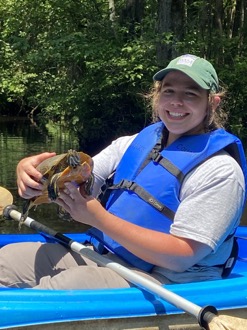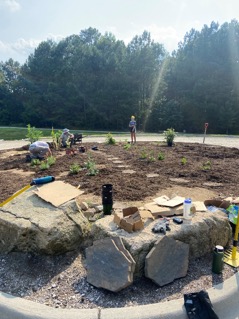Madison Allen: A Day in the Life of a Wake County Park Aide
I am on a kayak in a black water swamp, and everything is still. I look in the water but the only thing I can see is the reflection of the trees overhead. There are otherworldly sounds coming from the dense thicket of bald cypress trees to my right, that sound almost like what dinosaurs must have sounded like. The water is so dark because of the tannins, compounds that come from the decaying leaves that seep into the water and change the color. The crazy noise I hear is from the great blue heron rookery, signaling that the baby herons are hungry and awake. I see tiny, yellow prothonotary warblers swooping down in between branches, and several painted turtles perching on a log basking in the sun. This place is beautiful, and I get to experience it every day.

As a Park Aide for Wake County Parks, Rec, and Open Space, paddling Robertson Millpond is something that I get to do almost every day at work. It’s important to check the trails for downed logs or trees and to take note of any extra shallow points to ensure that the trail can be paddled. More than that, while paddling the pond, I must keep an inventory list of the different species I encounter. This includes plant and wildlife, down to the exact species and the total number that I see during my time observing. It is important that I am very specific with my lists and the dates in which I make my observations, as I later enter this information into the Natural Resources Inventory Database (NRID), which is a collection of all the sightings of different organisms on Open Space property in Wake County. This information can be used to discern trends in the number of species present at a certain time of year or how long plants stay in bloom. For instance, whenever I see a plant with its flowers open, I must note that it is “in bloom” when I enter the data into NRID. This data creates a bloom chart, which shows how early in the year that species has ever been seen starting to bloom to how late it has ever been seen in bloom. This data could help show different trends in the climate, perhaps depicting that it was a warm year if plants started blooming earlier than they usually do.

As a Park Aide, I work for Wake County, specifically under Parks Rec, and Open Space. One of the reasons I appreciated my work over the summer so much was because of the Open Space Program, which has a mission I admire. The county purchases plots of land and designates them as “open space”. These areas are set aside for different reasons, such as for historical or cultural significance, but most often for protection and preservation of our natural resources. Not only that, these open spaces are protected and kept from urban development, safeguarding the native plants and wildlife there. As an Environmental Science major, what other job could be better than one that aligns with everything I believe in and am going to school for?
My daily tasks changed over the summer depending on what projects me and the other Park Aides were working on at the time. One thing that stayed constant was the opening and closing of the preserves. As a Park Aide for Robertson Millpond and Turnipseed Nature Preserve, I had to ensure they were opened or closed on time, depending on which shift I worked. As opening or closing the gate and making sure everything is clean, stocked, and ready to go does not take too long, and I usually worked an 8-hour shift, there was plenty of time to do other things. While checking the paddling trails of Robertson and the hiking trails at Turnipseed were important, there was never a time where there was not a task that could be done. One of the summer projects I partook in was the monitoring of bluebird nests. At Turnipseed, there are several nest boxes that the eastern bluebird uses to lay eggs. As their population levels are declining, it is very important for us to do what we can to ensure the survival of the species. I worked alongside a volunteer twice a week to check the nest boxes and wax the pole to prevent predators from slithering up and predating upon the chicks. We reported our findings into NestWatch, a program that monitors the status of various birds across the country.

Another project I worked on was the creation of a pollinator garden. At Turnipseed, there was a roundabout that was just covered in grass, but over the summer I worked alongside my coworkers to transform the area into a native plant garden. We dug up the grass and got a truckful or two of dirt, compost, and mulch, then got to work planting native plants in the circle, even adding pavers to create a path for people to walk through the garden. It took a lot of hard work and many hours in the sun in the middle of a southeast summer, but the outcome was amazing. Most of the plants survived, and we received good feedback from patrons of the park, telling us how much they appreciated our efforts and the new path to walk through and admire the flowers. Since the planting, I have seen quite a few moths and butterflies in the area, so our pollinator garden had the desired outcome. A fall planting was even scheduled to add more plants, so next summer there should be even more pollinator visitors.
I had a truly fantastic experience working as a Park Aide over the summer, and I can say with confidence that I will never forget the experiences that made up my time there. Working towards the preservation of our natural resources and being able to work on land that was specifically set aside for the safety of our native plants and wildlife was amazing. Keeping spaces safe from urbanization and green and natural (or as “natural” as you can get with some aspect of human presence) is important to me. Plus, I got to be outside all day and not behind a desk, so it was a win in my book.
